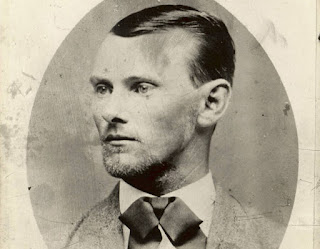The Death of Jesse James
Jesse Woodson James was shot in the back of the head in his house in St. Joseph, Missouri on April 3rd, 1882. Robert Ford was the man who pulled the trigger.
As someone who has lived in Missouri most of my life, I'm familiar with the exploits of the infamous James gang and I have even visited the house and museum in St. Joseph. I think I have even been to Kearney, Mo where he is buried. Growing up, we spent summers at my grandparents' farm in Iowa where my grandpa would regale us with stories about outlaws on Sunday mornings before church. Family lore says that my grandpa's dad fed and watered Frank James' horse when he was a kid--this was long after Jesse's death and when Frank was a traveling shoe salesman. That story has always stayed with me as have my grandpa's retellings of Jesse's death.
I find James' legacy fascinating, particularly in how small towns in the Midwest have some claim on his legendary exploits. When visiting two small towns in Iowa last summer, close to the family farm, I was surprised to encounter signs tracing the path the James gang took when they robbed a bank in 1871.
I went to Corydon and saw the safe, housed amidst an impressive recreation of the town's main street at that time (as far as small town museums go, this is one of the largest and most well-curated ones I have been to). It's strange to look at such a mundane object like a safe (albeit one that has been repainted) and think that because of one person's actions nearly 150 years ago, it now resides in a museum as a concrete object in a larger narrative--that of the infamous outlaw, the "Robin Hood" of the Midwest. Part of that narrative includes the many geographic locations that claim ties to his actions in some way. The banks, small towns, old farmhouses, and caves that provided a place to hide and a place to make a name for one's self.
While my fascination (stemming from childhood) with Jesse James will remain, I do acknowledge the problematic aspects of his mythical presence in the Midwest. Newspapers at the time glorified him as a hero, but the fact remains that he and his brother rode with Quantrill, broke the law, and murdered people. His family were Southern sympathizers, pro-Confederacy. I do not see my interest as one that glorifies him and his actions, but rather one that seeks to understand the full picture. To see how he fits within the larger narrative of Missouri history as well as U.S. History.
I've often written about the nostalgia I feel for my childhood and the summers I spent on a farm in Iowa. It's a theme I return to often as a way of making sense of other events in my life. I've included a brief excerpt from an unfinished nonfiction essay I started last year:
In the lore of Jesse James, it is often Frank James who is overlooked. As the older brother, he saw more action during the Civil War than Jesse. He rode with Quantrill first. I wonder if he liked being an outlaw after the war or if he embraced selling shoes as his true calling. From what I have read, he and Jesse were not close at the time of Jesse’s death. I wonder if he felt suddenly cut off when he heard the news. As if he now was missing a limb and would always feel the loss of it keenly until he died. Or maybe he was relieved to finally cut the final thread linking him to his outlaw past. Jesse, like Wild Bill, had turned his back to his killer. Perhaps one of the most haunting and inscrutable details about his death is that Jesse was dusting a picture of a horse when his supposed friend and fellow outlaw, Robert Ford, shot him in the back of the head. Maybe Bob did it purely for the money or out of a sense of self-preservation—either way, he involuntarily cemented Jesse James’ place as a mythical folk hero in his “cowardly” act.
Frank was left behind in the wake of Jesse’s death, as many people have been time and time again in the face of death. Family lore has it that my grandpa’s dad met Frank when he was a young boy. I suppose it would have been on one of Frank’s shoe selling trips. My great-grandpa watered his horse when Frank stopped at the family farm. That story has taken on a mythic element in my family history and perhaps it is part of the reason my grandpa told me so many stories about the James gang’s exploits. They robbed a bank nearly thirty miles from my grandpa’s farm. I’ve seen the safe in the small-town museum. There are signs everywhere in the area, proudly broadcasting claims of minor acts committed by the James gang—they bought horses in front of this hotel, robbed this bank here, the father of a famous jockey used to drive for Frank, etc. It has seeped into the water table at this point, the signs are so frequent.
Thank you for reading! If you are interested, read The Assassination of Jesse James by the Coward Robert Ford by Ron Hansen (the movie with Brad Pitt is based on it).








I like how you have pointed to the real, authentic uncertainty about how to understand the lives surrounding all of the Jesse James lore. Fun read! Keep up the good work!
ReplyDelete